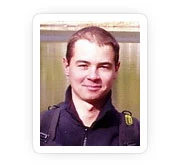Sitting Tall: Finding Ease in Yoga’s Most Basic Seated Position

Slumping the back and collapsing the chest is a common occurrence in Sukhasana (Easy Pose), especially in those who are new to yoga. Factors that can contribute to this posture include fatigue, defeated mental state, and tight muscle groups.

Many yoga poses are designed to counteract these factors, Sukhasana being one of them. Sitting up in Easy Pose helps to bring the spinal column into alignment so that the vertebral bodies and their discs support the torso. Expanding the chest forward enhances breathing. With practice, this can lead to a comfortable, easy position that is reflected in the central nervous system—an example of the mind/body connection in yoga.

Here’s the Cue
-
Place the hands with the palms facing down on the knees in Chin Mudra.
-
Then, while holding onto the knees, attempt to draw the hands back toward the torso. This engages the latissimus dorsi. The hands are constrained, so the force of contracting the latissimus is transmitted to its origin along the midline of the back. The result is what is known in kinesiology as a “closed chain” movement, whereby the origin of the muscle moves (instead of the insertion). Activating the lats in this manner lifts the spine and expands the chest forward.
-
If you tend to hyperextend the lumbar, then engage the abdominals to counteract this. Note the effect.
Slumping tilts the pelvis backward into retroversion so that one is sitting on the back part of the ischial tuberosities (the sitting bones). A portion of the latissimus dorsi originates from the back of the iliac crest,  so that activating this muscle also tilts the pelvis forward, bringing the sitting bones more upright.
so that activating this muscle also tilts the pelvis forward, bringing the sitting bones more upright.
This technique is portable to other poses. In Tadasana, for example, simply fix the palms against the sides of the hips and attempt to drag them backward. Note how the chest expands forward, and the back straightens. See this concept in action for Sukhasana in the video above.
Here are the Anatomy and Biomechanics. . .
The latissimus dorsi originates from the spinous processes of thoracic vertebrae 6—12, lumbar vertebrae 1—5 (via the thoracolumbar fascia), ribs 9—12, the supraspinous ligament, and the posterior third of the ilium. It inserts onto the intertubercular groove on the humerus and the deep fascia of the arm. The latissimus dorsi extends, adducts, and internally rotates the shoulder (open chain movement). It extends the spine and lifts and tilts the pelvis forward (closed chain movement) and is also an accessory muscle of respiration.
Reprinted with permission from Daily Bandha.
Illustrations by the Daily Bandha.
 Author Ray Long MD, FRCSC is a board-certified orthopedic surgeon and the founder of Bandha Yoga. Ray graduated from The University of Michigan Medical School with post-graduate training at Cornell University, McGill University, The University of Montreal and Florida Orthopedic Institute. He has studied hatha yoga for over twenty years, training extensively with B.K.S. Iyengar and other leading yoga masters.
Author Ray Long MD, FRCSC is a board-certified orthopedic surgeon and the founder of Bandha Yoga. Ray graduated from The University of Michigan Medical School with post-graduate training at Cornell University, McGill University, The University of Montreal and Florida Orthopedic Institute. He has studied hatha yoga for over twenty years, training extensively with B.K.S. Iyengar and other leading yoga masters.
 3d Graphic Designer / Illustrator Chris Macivor has been involved in the field of digital content creation for well over ten years. He is a graduate of Etobicoke School of the Arts, Sheridan College and Seneca College. Chris considers himself to be equally artistic and technical in nature. As such, his work has spanned many genres from film and television to video games and underwater imagery.
3d Graphic Designer / Illustrator Chris Macivor has been involved in the field of digital content creation for well over ten years. He is a graduate of Etobicoke School of the Arts, Sheridan College and Seneca College. Chris considers himself to be equally artistic and technical in nature. As such, his work has spanned many genres from film and television to video games and underwater imagery.



